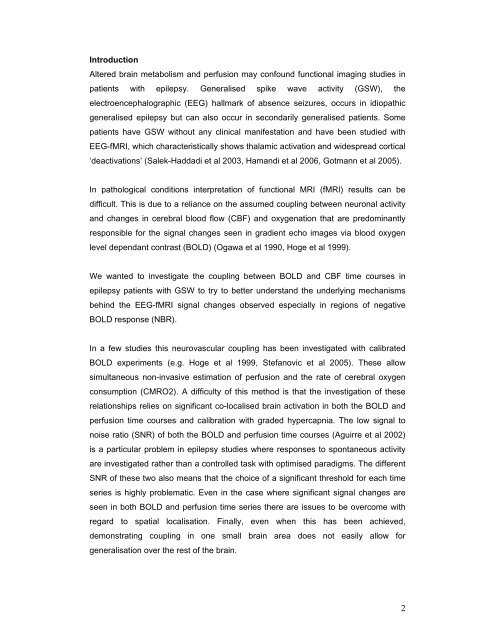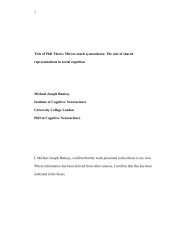An investigation of the relationship between BOLD and perfusion ...
An investigation of the relationship between BOLD and perfusion ...
An investigation of the relationship between BOLD and perfusion ...
Create successful ePaper yourself
Turn your PDF publications into a flip-book with our unique Google optimized e-Paper software.
Introduction<br />
Altered brain metabolism <strong>and</strong> <strong>perfusion</strong> may confound functional imaging studies in<br />
patients with epilepsy. Generalised spike wave activity (GSW), <strong>the</strong><br />
electroencephalographic (EEG) hallmark <strong>of</strong> absence seizures, occurs in idiopathic<br />
generalised epilepsy but can also occur in secondarily generalised patients. Some<br />
patients have GSW without any clinical manifestation <strong>and</strong> have been studied with<br />
EEG-fMRI, which characteristically shows thalamic activation <strong>and</strong> widespread cortical<br />
‘deactivations’ (Salek-Haddadi et al 2003, Ham<strong>and</strong>i et al 2006, Gotmann et al 2005).<br />
In pathological conditions interpretation <strong>of</strong> functional MRI (fMRI) results can be<br />
difficult. This is due to a reliance on <strong>the</strong> assumed coupling <strong>between</strong> neuronal activity<br />
<strong>and</strong> changes in cerebral blood flow (CBF) <strong>and</strong> oxygenation that are predominantly<br />
responsible for <strong>the</strong> signal changes seen in gradient echo images via blood oxygen<br />
level dependant contrast (<strong>BOLD</strong>) (Ogawa et al 1990, Hoge et al 1999).<br />
We wanted to investigate <strong>the</strong> coupling <strong>between</strong> <strong>BOLD</strong> <strong>and</strong> CBF time courses in<br />
epilepsy patients with GSW to try to better underst<strong>and</strong> <strong>the</strong> underlying mechanisms<br />
behind <strong>the</strong> EEG-fMRI signal changes observed especially in regions <strong>of</strong> negative<br />
<strong>BOLD</strong> response (NBR).<br />
In a few studies this neurovascular coupling has been investigated with calibrated<br />
<strong>BOLD</strong> experiments (e.g. Hoge et al 1999, Stefanovic et al 2005). These allow<br />
simultaneous non-invasive estimation <strong>of</strong> <strong>perfusion</strong> <strong>and</strong> <strong>the</strong> rate <strong>of</strong> cerebral oxygen<br />
consumption (CMRO2). A difficulty <strong>of</strong> this method is that <strong>the</strong> <strong>investigation</strong> <strong>of</strong> <strong>the</strong>se<br />
<strong>relationship</strong>s relies on significant co-localised brain activation in both <strong>the</strong> <strong>BOLD</strong> <strong>and</strong><br />
<strong>perfusion</strong> time courses <strong>and</strong> calibration with graded hypercapnia. The low signal to<br />
noise ratio (SNR) <strong>of</strong> both <strong>the</strong> <strong>BOLD</strong> <strong>and</strong> <strong>perfusion</strong> time courses (Aguirre et al 2002)<br />
is a particular problem in epilepsy studies where responses to spontaneous activity<br />
are investigated ra<strong>the</strong>r than a controlled task with optimised paradigms. The different<br />
SNR <strong>of</strong> <strong>the</strong>se two also means that <strong>the</strong> choice <strong>of</strong> a significant threshold for each time<br />
series is highly problematic. Even in <strong>the</strong> case where significant signal changes are<br />
seen in both <strong>BOLD</strong> <strong>and</strong> <strong>perfusion</strong> time series <strong>the</strong>re are issues to be overcome with<br />
regard to spatial localisation. Finally, even when this has been achieved,<br />
demonstrating coupling in one small brain area does not easily allow for<br />
generalisation over <strong>the</strong> rest <strong>of</strong> <strong>the</strong> brain.<br />
2

















